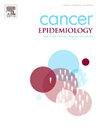当地晚期角化细胞癌的社会经济、健康相关和地理危险因素:丹麦一项基于全国人群的研究
IF 2.3
3区 医学
Q3 ONCOLOGY
引用次数: 0
摘要
大多数角化细胞癌(KC)是局部和缓慢生长的。然而,对于一些患者,KC可能成为局部晚期病变,并导致大量组织损伤,需要广泛的手术治疗。我们希望探索局部晚期疾病的危险因素,以提供更及时的诊断和治疗。方法:本研究采用多变量logistic回归分析,对2007年至2021年首次诊断为基底细胞癌(BCC)或鳞状细胞癌(SCC)的患者进行人口统计学因素、教育水平、可支配收入、同居状况、共病和居住地区与肿瘤(T)类别的关系进行研究。结果共发现166,467例BCC和36,609例SCC患者。男性、老年、低教育水平和可支配收入、独居和合并症与发生≥T2肿瘤的较高几率相关。首都地区以外的居住地增加了本地晚期BCC的风险,而在新西兰、中部和北部地区,本地晚期SCC的风险更高。结论社会经济地位、合并症、居住地区与BCC和SCC发生≥T2肿瘤的风险有显著相关性。加强早期发现和治疗的努力应侧重于弱势群体。本文章由计算机程序翻译,如有差异,请以英文原文为准。
Socioeconomic, health-related and geographical risk factors for locally advanced keratinocyte carcinoma: A nationwide population-based study in Denmark
Background
Most keratinocyte carcinomas (KC) are localized and slow-growing. However, for some patients, KC can become locally advanced lesions and cause substantial tissue damage that require extensive surgery to manage. We wanted to explore risk factors for locally advanced disease with the overall aim to offer more timely diagnosis and treatment.
Methods
This nationwide, register-based cohort study examined the association of demographic factors, educational level, disposable income, cohabitating status, comorbidity, and region of residence with tumor (T) category for patients with a first-time diagnosis of basal cell carcinoma (BCC) or squamous cell carcinoma (SCC) from 2007 to 2021, using multivariable logistic regression analyses.
Results
We identified 166,467 BCC and 36,609 SCC patients. Male sex, old age, lower educational level and disposable income, living alone, and comorbidity were linked to higher odds of developing a ≥T2 tumor. Residence outside the Capital Region increased the risk of locally advanced BCC, while the risk of locally advanced SCC was higher in the Zealand, Central, and Northern regions.
Conclusion
There are significant associations between socioeconomic status, comorbidity, and region of residence and the risk of developing ≥T2 tumors in both BCC and SCC. Efforts to enhance early detection and treatment should focus on vulnerable individuals.
求助全文
通过发布文献求助,成功后即可免费获取论文全文。
去求助
来源期刊

Cancer Epidemiology
医学-肿瘤学
CiteScore
4.50
自引率
3.80%
发文量
200
审稿时长
39 days
期刊介绍:
Cancer Epidemiology is dedicated to increasing understanding about cancer causes, prevention and control. The scope of the journal embraces all aspects of cancer epidemiology including:
• Descriptive epidemiology
• Studies of risk factors for disease initiation, development and prognosis
• Screening and early detection
• Prevention and control
• Methodological issues
The journal publishes original research articles (full length and short reports), systematic reviews and meta-analyses, editorials, commentaries and letters to the editor commenting on previously published research.
 求助内容:
求助内容: 应助结果提醒方式:
应助结果提醒方式:


